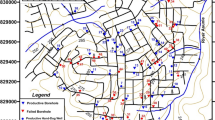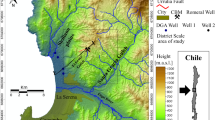Abstract
We analyzed the abundance and connectivity of Cambrian limestone aquifers (CL) using data from geological and hydrogeological boreholes, groundwater tracer tests, groundwater temperature monitoring, and surface transient electromagnetic exploration (TEM). Our results demonstrate that extremely well-developed small faults with an average density of number 73 per square km control the groundwater abundance and flow of the CL. The hydraulic conductivity of the CL aquifers estimated by tracer tests lies between 13,511 and 38,738 m/d, suggesting good connectivity. The surface TEM result of 4.91 km2 shows that areas with an apparent resistivity value less than 30 Ωm can be treated as an anomalous low-resistivity zone. This has been proven to be reliable by experience at the working face and can be used to determine water control measures for future mining. Using these data, we developed a series of preventive measures to mitigate potential floor water ingress related to future mining in the eastern area of the Pingdingshan coalfield No. 2 mine.
Zusammenfassung
Untersucht wurden Verbreitung und Konnektivität kambrischer Kalksteinaquifere (CL) anhand geologisch-hydrogeologischer Bohrlochdaten, Grundwassertracertests, Grundwassertemperaturdaten und Oberflächen-Transienten-Elektromagnetik (TEM). Die Ergebnisse zeigen, dass sehr gut entwickelte kleine Störungen mit einer Dichte von durchschnittlich 73 Stück je km2 bestimmend sind für Grundwasserführung und -strömung. Die anhand von Tracertests abgeschätzte hydraulische Durchlässigkeit der CL-Aquifere liegt zwischen 13,511 und 38,738 m/d, was auf eine gute Konnektivität hinweist. Die Ergebnisse der auf einer Fläche von 4.91 km2 durchgeführten Oberflächen-TEM zeigen, dass Areale mit scheinbaren Widerstandswerten kleiner 30 Ω*m als niederohmige Widerstandsanomalien ausgehalten werden können. Dieses Ergebnis wird durch die praktischen Erfahrungen im Abbaubetrieb bestätigt und kann damit zur Ableitung von Maßnahmen zur Verhinderung von Wassereinbrüchen verwendet werden. Unter Nutzung dieser Daten wurde eine Serie von Vorsorgemaßnahmen zur Verhinderung potentieller Liegendwassereinbrüche im Zusammenhang mit künftigem Bergbau im Ostteil der Grube 2 des Pingdingshan Kohlefeldes entwickelt.
利用地质和水文地质钻探、地下水示踪、地下水温度监测和地面瞬变电磁勘探分析了寒武系灰岩含水层(CL)的富水性和导水性。结果表明, 平均密度73条/平方公里的密集小断裂控制着寒武系岩溶水的富水性和径流。示踪法估算寒武系含水层渗透系数范围13,511~38,938 m/d, 导水性非常好。面积4.91 km2地面瞬变电磁勘探表明, 视电阻率小于30 Ω*m的区域可视为低阻异常区。该结果已为工作面揭露所证实, 可用以规划未来煤矿防治水方案。基于此, 提出系列减缓平顶山煤田2矿东部潜在底板突水危险性的防治水措施。
Resumen
Hemos analizado la abundancia y conectividad de los acuíferos de caliza cámbrica (CL) usando datos de agujeros de perforación geológicos e hidrogeológicos, ensayos con trazas en aguas subterráneas, monitoreo de la temperatura del agua subterránea y exploración electromagnética transiente superficial (TEM). Nuestros resultados demostraron que las pequeñas fallas extremadamente bien desarrolladas con una densidad promedio de 73 por km cuadrado controlan la abundancia de agua subterránea y el flujo de la CL. La conductividad hidráulica de los acuíferos CL estimada por los ensayos con trazas está entre 13,511 y 38,738 m/d, sugiriendo una buena conductividad. El resultado de la TEM superficial de 4.91 km2 muestra que las áreas con valores aparentes de resistividad menores que 30 Ω*m pueden ser tratadas como zonas anómalas de baja resistividad. Esto ha demostrado ser confiable de acuerdo a la experiencia en la cara de trabajo y se puede utilizar para determinar las medidas de control de agua para los futuros trabajos mineros. Usando estos datos, desarrollamos una serie de medidas preventivas para mitigar el potencial ingreso de agua a través del piso que podría producirse en los futuros trabajos mineros en el área este de la mina No. 2 del campo de carbón Pingdingshan.





Similar content being viewed by others
References
Anandan KS, Sahay SN, Ramabadran TK, Shiv PS (2010) Groundwater control techniques for safe exploitation of the Neyveli lignite deposit, Cuddalore district, Tamil Nadu, India. Mine Water Environ 29(1):3–13
Andrea B, Philippe R, Fabien C (2016) Can one identify karst conduit networks geometry and properties from hydraulic and tracer test data? Adv Water Resour 90:99–115
Attila K, Pierre P, Enikő D, László L, Péter S (2015) Well hydrograph analysis for the characterisation of flow dynamics and conduit network geometry in a karst aquifer, Bükk Mountains, Hungary. J Hydrol 530(2):484–499
Cao BQ, Wang XY, Zhang JL (2014) Analysis on temperature distribution and influencing factors in Pingdingshan coal field. Coal Technol 33(7):73–75 [Chinese, with English abstract]
Ghasemizadeh R, Hellweger F, Butscher C, Padilla I, Vesper D, Field M, Alshawabkeh A (2012) Groundwater flow and transport modeling of karst aquifers, with particular reference to the north coast limestone aquifer system of Puerto Rico. Hydrogeol J 20(8):1441–1461
Howladar MF, Deb P, Huqe Muzemder AS (2017) Monitoring the underground roadway water quantity and quality for irrigation use around the Barapukuria Coal Mining Industry, Dinajpur, Bangladesh. Groundw Sustain Dev (4):23–34
Huang PH, Chen JS (2012) Recharge sources and hydrogeochemical evolution of groundwater in the Coal-Mining district of Jiaozuo, China. Hydrogeol J 20(4):739–754
Jing GX, Li DH, Wang XY, Liu XM (2014) Expert interpretation of coal mine safety regulations; relevant laws and regulations of coal mine safety. Provisions on Prevention and Control of Water in Coal Mines. China Univ of Mining and Technology Press, Xuzhou [Chinese]
Lambán LJ, Jódar J, Custodio E, Soler A, Sapriza G, Soto R (2015) Isotopic and hydrogeochemical characterization of high-altitude karst aquifers in complex geological settings. The Ordesa and Monte Perdido National Park (Northern Spain) case study. Science Total Environ 506–507:466–479
Li PY, Hui Qian H, Howard Ken WF, Wu JH (2015) Building a new and sustainable “silk road economic belt”. Environ Earth Sci 74(10):7267–7270
Li PY, Wu JH, Qian H (2016) Preliminary assessment of hydraulic connectivity between river water and shallow groundwater and estimation of their transfer rate during dry season in the Shidi River, China. Environ Earth Sci 75:99
Li PY, Qian H, Zhou WF (2017a) Finding harmony between the environment and humanity: an introduction to the thematic issue of the Silk Road. Environ Earth Sci 76:105
Li RZ, Wang Q, Wang XY, Liu XM, Li JL, Zhang YX (2017b) Relationship analysis of the degree of fault complexity and the water irruption rate, based on fractal theory. Mine Water Environ 36(1):18–23
Price M, Low RG, McCann C (2000) Mechanisms of water storage and flow in the unsaturated zone of the Chalk aquifer. J Hydrol 233(1–4):54–71
Qian JZ, Wang L, Ma L, Lu YH, Zhao WD, Zhang Y (2016) Multivariate statistical analysis of water chemistry in evaluating groundwater geochemical evolution and aquifer connectivity near a large coal mine, Anhui, China. Environ Earth Sci 75(9):747
Shi XX, Wu K (2011) Down-hole electromagnetic method for detecting water hazard of coal mine. Proc Environ Sci 11(1):970–976
State Administration of Work Safety in China, State Administration of Coal Mine Safety in China (2009) Provisions on prevention and control of water in coal mines. China Coal Industry Publishing House, Beijing [in Chinese]
Sun WJ, Wu Q, Liu HL, Jiao J (2015) Prediction and assessment of the disturbances of the coal mining in Kailuan to karst groundwater system. Phys Chem Earth 89–90:136–144
Valipour M (2016) How much meteorological information is necessary to achieve reliable accuracy for rainfall estimations? Agriculture 6(4):53
Wang Q, Wang XY, Hou QL (2016a) Geothermal water at a coal mine: from risk to resource. Mine Water Environ 35(3):294–301
Wang XY, Ji HY, Wang Q, Liu XM, Huang D, Yao XP, Chen GS (2016b) Divisions based on groundwater chemical characteristics and discrimination of water inrush sources in the Pingdingshan coalfield. Environ Earth Sci 75(10):872
Wang XY, Wang TT, Wang Q, Liu XM, Li RZ, Liu BJ (2017) Evaluation of floor water inrush based on fractal theory and an improved analytic hierarchy process. Mine Water Environ 36(1):87–95
Williams PW (2008) The role of the epikarst in karst and cave hydrogeology: a review. Int J Speleol 37(1):1–10
Wilson YF (2010) Hydrochemical and isotopic evidence of recharge, apparent age, and flow direction of groundwater in Mayo Tsanaga River Basin, Cameroon: bearings on contamination. Environ Earth Sci 60(1):107–120
Wu Q, Zhao SQ, Dong SN (2013) Mine Water Control Manual. China Coal Industry Publishing House, Beijing [in Chinese]
Yin SX, Zhang JC, Liu DM (2015) A study of mine water inrushes by measurements of in situ stress and rock failures. Nat Hazards 79:1961–1979
Yin SX, Han Y, Zhang YS, Zhang JC (2016) Depletion control and analysis for groundwater protection and sustainability in the Xingtai region of China. Environ Earth Sci 75(18):1246
Zhang JG, Wang LH, Kang GF, Zhang PQ, Song DX, Wang SS (2012) Coal mine limestone water regional governance 2012–2015 plan of China Pingdingshan Coal Group. China Univ of Mining and Technology Press, Xuzhou [Chinese]
Acknowledgements
This work was financially supported by the National Natural Science Foundation of China (Grants 41272250 and 41672240), Henan Province’s Technological Innovation Team of Colleges and Universities (Grant 15IRTSTHN027), Innovation Scientists and Technicians Troop Construction Projects of Henan Province (Grant CXTD2016053), and the Fundamental Research Funds for the Universities of Henan Province (Grant NSFRF1611). The authors sincerely thank Mr. Jin Yan and Mr. Wenming Lin of the Pingdingshan Tian’an Coal Co. Ltd No. 2 mine for their valuable assistance.
Author information
Authors and Affiliations
Corresponding author
Rights and permissions
About this article
Cite this article
Wang, Q., Wang, X., Liu, X. et al. Prevention of Groundwater Disasters in Coal Seam Floors Based on TEM of Cambrian Limestone. Mine Water Environ 37, 300–311 (2018). https://doi.org/10.1007/s10230-017-0500-2
Received:
Accepted:
Published:
Issue Date:
DOI: https://doi.org/10.1007/s10230-017-0500-2




